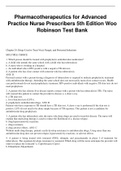Tentamen (uitwerkingen)
Pharmacotherapeutics for Advanced Practice Nurse Prescribers 5th Edition Woo Robinson Test Bank Chapter 24. Drugs Used to Treat Viral, Fungal, and Protozoal Infections
- Vak
- Instelling
Pharmacotherapeutics for Advanced Practice Nurse Prescribers 5th Edition Woo Robinson Test Bank Chapter 24. Drugs Used to Treat Viral, Fungal, and Protozoal Infections
[Meer zien]




